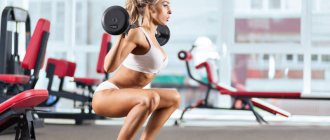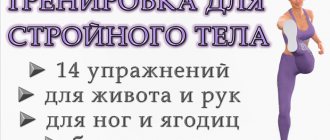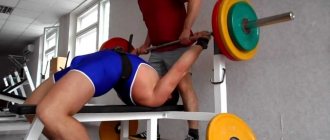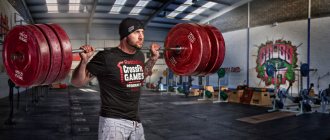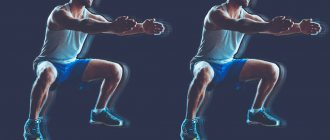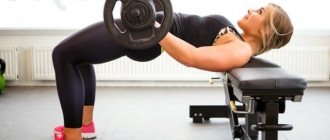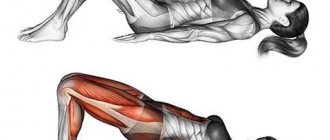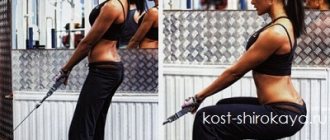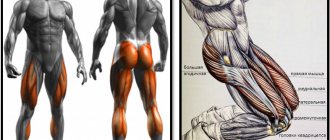Squats are one of the most effective basic exercises in fitness. First of all, it is aimed at developing the muscles of the lower body. But, besides this, squats have a comprehensive effect on the whole body, strengthening the abs and core muscles. Therefore, by regularly squatting, you can count on improving your posture and overall figure. Squats are especially popular among girls. After all, this is one of the most effective exercises for strengthening the legs and buttocks.
You can speed up the achievement of results by squatting according to specially developed programs. This is convenient and allows you to track your progress in training.
- Standard for buttocks
What happens to your body if you squat 100 times every day?
Squats for weight loss
If your weight is 75–80 kg, then by doing 100 squats every day for 5 minutes, you will burn about 40–45 calories (the higher your weight, the more calories you will burn).
Using weights (for example, dumbbells), you can increase this figure to 200 - 400 calories.
By squatting and following the principles of rational nutrition, in just 2 weeks you will lose at least 1 – 2 kg.
Benefits of squats for weight loss:
- Acceleration of metabolic processes.
- Saturation of the body with oxygen.
Squats for figure
After 6 - 8 weeks of daily squats 100 times, you will notice the following changes:
- The hip line will become clearer and rounder.
- The buttocks will gain elasticity.
- The abdominal press will be strengthened.
- The inner and outer thigh muscles will tighten.
- Your posture will be straightened.
- In men, the leg muscles will become more prominent.
- In women, the waist will decrease in volume by several centimeters.
In addition, during squats, the abdominal wall contracts rhythmically, which helps strengthen the abdominal muscles.
But truly visible results for the buttocks and waist can be achieved by gradually increasing the number of squats to 200 or more per day, and it is recommended to squat with weights.
Squats for endurance
After the first two days of squats (especially if you do them incorrectly and are overzealous), you will feel nothing but fatigue and severe muscle pain. And the main thing here is not to give up, but to continue to squat every day.
On the sixth day, 100 squats will be much easier for you.
On the tenth day, you will notice that the muscles in your legs have begun to acquire, albeit slightly, relief.
After 3 weeks, you will not only easily complete a hundred squats, but you will also notice that your legs have become much stronger. Now the morning long-distance run will not be accompanied by pain in the legs and shortness of breath.
Squats for work ability
During squats, blood circulation increases, which has a beneficial effect on blood vessels and brain cells, which are enriched with oxygen.
By squatting 100 times every day, you will become:
- more energetic
- more concentrated
- more carefully,
- more stress-resistant.
Squats for the Heart
By squatting 100 times a day, you will increase venous circulation in the legs and blood flow directly to the heart, thereby facilitating its work, since any cardio load (and squats without weights are specifically cardio load) trains the heart muscle.
Squats are also useful for normalizing the functioning of the nervous and respiratory systems, as well as the vestibular apparatus.
Squats for injury prevention
Intense physical activity can negatively affect the condition of ligaments and joints. If you want to avoid these problems, you need to train the muscles of your lower body. And regular squats will help you with this.
By performing 100 or more shallow squats daily, you will improve the condition of your joints, which will stop “crunching”, strengthen your knees, ankles, as well as the muscles of your legs and back, which is an excellent prevention of sports injuries.
But keep in mind that deep squats put intense stress on your knees, so if you have problems with your knees, then practice static shallow squats.
Are there any contraindications?
Squats will give you health, good spirits and improve your figure, but when building your gluteal muscles, you should not forget about contraindications, the list of which is given below:
- Joint disease and scoliosis. During squats, the joints of the legs and back receive significant stress; exercises can aggravate the situation and trigger unpleasant processes. If a person has pain in his joints during prolonged walking, running, or “due to the weather,” then it is recommended to visit a doctor before starting classes.
- Overweight. In itself, extra pounds are already a serious burden on the cardiovascular system, and physical activity in addition can seriously worsen your health. Therefore, fitness trainers recommend that especially obese people start with a small number of squats, allowing the body to get used to the load, and only then gradually move to increase the volume of exercises.
- Last trimester of pregnancy. Here, expert opinions are divided; many argue that stress on the legs and pelvic area can negatively affect the development of the fetus and lead to unpleasant consequences, however, there are also defenders of sports activity in the later stages of the prenatal period. The decisive condition will be the well-being of the pregnant woman and a special lightweight training program.
- Varicose veins With this disease, excessive stress on the legs is contraindicated, so you should probably refrain from squats.
Types of squats at home
The most common type of squats is classic. Stand straight, feet shoulder-width apart, arms extended forward. The back and neck are straight. As you inhale, slowly lower yourself down. At the bottom point, fixate for a second and, exhaling, return to the starting point.
Others are based on this type of exercise:
- Deep. Its technique is similar to the type described above, only the pelvis needs to be lowered slightly below the knee line. In this case, his muscles will stretch and tense more.
- On one leg. Stand up straight. Raise one of your lower limbs up in front of you without bending the knee. Stretch your upper limbs forward. Squat down slowly without lowering or bending your raised leg. At the bottom point, the raised leg and the thigh of the working leg should form a single straight line. Rise also slowly, while lowering your arms.
- With weights. You can use a barbell as a load. Stand up straight and place the apparatus on your shoulders. Spread your feet 50-60 cm from one another. Slowly lower yourself down, trying to squat as deeply as possible. The back should remain straight. Also slowly return to the starting point.
- Plie (sumo, squat) with wide legs. Spread your feet as wide as possible. Turn your socks in different directions. Back straight, look ahead. Slowly lower yourself down until your thighs form a right angle with your shins. Fix for a second or two at this point and smoothly return to the starting point. To complicate the exercise, you can squat with a weight (dumbbell), but only after the technique has been worked out.
- With narrow leg position. It is difficult to perform this exercise without special preparation, as it requires good muscle stretching and ligament flexibility. Place your feet narrower than shoulder width. The following steps are similar to classic squats.
Curtsy. It is a combination of lunges and squats. Stand straight, feet shoulder-width apart or slightly narrower (as you prefer). Step one leg back so that your feet are on the same diagonal. Keep your body weight on your working leg, the second one stands on the “pad”. Start squatting until the thigh of your supporting leg forms an angle with your shin. The knee of the second leg is a short distance from the floor. Straighten up and put your foot down. Then you can change it, performing the exercise in turn for each limb (or perform it first for one and then for the other).
Top 5 exercises for buttocks
The buttocks are used in a large number of exercises. To pump up your butt in a month at home or in the gym, it is recommended to choose only the most effective movements.
Squats
Without this exercise, it is almost impossible to build powerful and voluminous buttocks. However, for the exercise to provide maximum benefit, you need to squat as low as possible (not to parallel).
Technique:
- Place the barbell on your shoulders and remove it from the rack. Feet are shoulder-width apart or slightly wider than shoulder-width apart, toes turned out to the sides at an angle of 45 degrees.
- Slowly lower yourself down without lifting your heels off the floor.
- Without pausing at the bottom, rise while exhaling at the same time.
During the exercise, it is important to keep your back straight and not “fall” down (the squat should be controlled, at a moderate pace). For better core stabilization and lifting heavy weights, it is recommended to do squats in a Smith machine.
Romanian deadlift
One of the most effective movements for the gluteal area and the back of the thighs. If we consider whether it is possible to pump up your butt in a month without using the Romanian deadlift, then the answer will be clearly negative.
Technique:
- Remove the barbell from the supports, stand up straight and hold it with your free hands. Feet shoulder-width apart or slightly narrower.
- Begin to slowly lean your body forward, keeping your back straight.
- At the bottom point, take a short pause, then return to the starting position at a faster pace.
An indicator of correct execution of the movement will be a strong pulling sensation in the buttocks, hamstrings and calves.
Pelvic bridge
Definitely the most powerful movement when it comes to targeted loading of the buttocks. Unlike squats, the load is predominantly placed on the target area. Another advantage of the glute bridge is that in this movement you can work with very heavy weights without the risk of injury.
Technique:
- Lie on the floor, rest on your heels and bend your knees. The pelvis should lie on the floor (the weight is placed in the lower abdomen, just above the hips).
- Raise your pelvis up until your body forms a straight line from your knees to your shoulders.
- With a minimum pause, lower your pelvis down and repeat the movement (full lowering of the pelvis to the floor is allowed).
During the exercise, it is important not to lift your back and the back of your head from the surface (floor or bench), working only in the hip joint. To make the exercise more difficult, the pelvic bridge is performed in a horizontal position.
To make the exercise more difficult, the pelvic bridge is performed in a horizontal position.
- The emphasis is on the feet (with a right angle at the knee).
- The shoulder blades and neck lie on the bench.
Lunges
The most universal exercise not only for the buttocks, but also for the entire lower body. Evenly loads almost all muscles. It is recommended to perform different types of lunges (forward, reverse, Bulgarian squats, cross-legged) to ensure maximum load on the glutes.
Execution technique (classic forward lunges):
- Take dumbbells in your hands and stand straight. Legs at shoulder level.
- Take a wide step forward with your right foot.
- Simultaneously with the step, bend your left leg at the knee (so that the knee does not touch the floor).
- Pause briefly and without jerking, rise to the starting position at the same pace.
- Repeat the movement on the other leg.
Types of squats
Squats for 30 days are a great way to tighten the muscles of your thighs and buttocks. They help improve blood circulation, break up unsightly cellulite, have a beneficial effect on health and stamina, and make muscles healthy, strong and elastic. This is also a simple exercise, for which we do not need either specialized equipment or a large amount of space, it burns fat remarkably, improves coordination of movements, and has a beneficial effect on the functioning of the heart and blood vessels, and metabolism.
For a person of average height and build, five minutes of squats is an opportunity to burn about 43 kcal. For people with more weight, the number of calories increases. You can perform the exercise on one or two legs, with or without weights. In general, it has a lot of variations, and for better effectiveness, it is desirable that the 30-day set of squats for buttocks includes different versions of squats. Let's look at some variations.
Basic squat
You need to stand on the floor, place your feet shoulder-width apart. Then squat until you are parallel to the floor, as if you were trying to sit on a low bench. While performing the exercise, keep your back straight, do not round it or bend forward.
Beginners are recommended to start squatting in front of a mirror. This will help you control the technique of performing the exercise and correct errors immediately after you notice them.
Wide stance squat
Your legs should be placed slightly wider than shoulder level, and your feet should be turned out to the sides. The knees should be spread as wide as possible, lowering as you inhale at a slow pace and making several springy movements. Rise as you exhale. One variation of this exercise is the plie squat. They are considered very effective, and are especially popular among girls, so the 30-day squat chart may include them too.
Narrow stance squat
For this exercise you need to bring your feet together. Close your knees and place your hands on your hips. Inhaling, slowly lower yourself. As you exhale, rise up. To maintain balance, you can stretch your arms forward and tilt your body slightly. Remember to use a springy motion.
Squats with legs wide apart train the inner thigh better, while exercises in a narrow stance train the outer thigh.
In addition, you can add various variations of the basic exercise to the squat schedule for girls for 30 days, which will make it more difficult:
- On the way up, kick back.
- Crouching, lower your hands to the floor. When standing up, lift them above your head and draw them as if in a circle.
- Squat down with your hands behind your head. When standing up, pull your knee towards your elbow.
- As you rise from the squat, jump up.
- Lift one leg off the floor and lower yourself onto the other.
- Leave one leg back and sit down on the front one.
- Spread your legs to the sides in a jump, squat down.
For squats, you can use dumbbells or a barbell. Read all about the types of squats with dumbbells in hands for girls here. When you go down, the muscles in your buttocks and back are tense, and when you go up, your own weight will be a burden. Hands stretched forward, crossed over the shoulders or gathered at the waist will help you maintain your balance.
Squat not on your toes, but on your full foot. You should not hold your breath. When doing lunges, put your leg out as far as possible so that the gluteal muscles stretch more. To improve the effectiveness of the exercise and speed up the achievement of results, you can combine squats with abdominal exercises, push-ups, and cardio exercises. This will help both improve the shape of the buttocks and hips, and reduce the size of the waist and abdomen.
Before planning a squat regimen for girls for 30 days, be sure to make sure there are no contraindications. Among them are injuries to the knees, ankles, hip joints, and recent fractures in the lower body. You should not squat during pregnancy or if you have a lot of excess weight, as this increases the risk of knee injury.
Choosing the right weight of weights
One of the main components of the success of the 30-day course of squats for the buttocks is the optimal choice of weighting material and its weight.
For beginners, fitness instructors advise starting with a weight of 1-2 kilograms. The most convenient weights for beginners would be small dumbbells in their hands or a budget option - one and a half liter bottles filled with water.
Experts recommend purchasing a plate weight belt. In such a belt, plates can be added or removed depending on the desired load, in addition, the belt can be picked up during squats, which will allow you to use the arm muscles.
More advanced athletes can use weights of 3-6 kilograms; such a weight will allow you to work not only the gluteal muscles, but will also create an attractive relief for the forearms, and also strengthen the back muscles.
Types of squats
Squats to parallel
Performed in such a way that the thighs are parallel to the floor during the squat.
To learn how to properly perform squats to parallel, you can use a chair as a handy tool.
Squat technique:
- Sit on the edge of the chair.
- Place your feet hip-width apart.
- Place your heels below the level of your knees.
- Push yourself up using the force of your gluteal muscles (you can help yourself by swinging your arms).
- Do a squat until your buttocks touch the chair.
- Make sure your knees do not go further forward than your toes.
It is important to choose the right chair for squats, the height of which should be such that when sitting on it, the thighs are strictly parallel to the floor, while the entire surface of the foot is on the floor
Plie squats
This type of squat effectively targets the buttocks, calves, and thighs (especially the inner thighs).
Plie technique:
- Spread your legs wide, with your knee pointing toward your big toe.
- Bend your knees slightly.
- Place your hands on your hips or cross them in front of you.
- Pull your stomach in.
- Squat on a deep breath with a perfectly straight back, looking ahead.
- At the bottom of the squat, the thighs are parallel to the floor, while the projection of the knee should not extend beyond the foot.
- Hold the position for 2 - 3 seconds, then exhale and return to the starting position without straightening your legs completely.
By performing plie squats every day, you:
- Round your buttocks.
- Unload your spine.
- Strengthen your lower body.
Sumo squats
This type of squats is similar in technique to plie. But there are still differences.
Sumo squat technique:
- Spread your legs as wide as possible.
- Turn your knees in different directions.
- Bend your back forward and move your pelvis back (imagine that there is a chair behind you that you need to sit on).
- Do a squat and hold the position for a few seconds.
- Take the starting position without fully extending your knees.
Sumo squats are a great option for girls who want to make their buttocks more elastic and sculpted.
Pistol squats
Pistol squats allow you to actively work out your quadriceps, build muscle mass, and improve flexibility and coordination.
Beginners are advised to start squatting using a support: a bench or chair.
Supported squat technique:
- We stand in front of the support.
- We stretch our arms forward or spread them to the sides (this will help maintain balance).
- We raise one leg in front of us and straighten it.
- While inhaling smoothly, bend the other leg at the knee and sit down on the support.
- As you exhale, push the body to the starting position.
At first, you will not sit down, but literally fall onto the chair, but over time you will be able to perform the exercise smoothly and without support.
Technique for performing pistol squats without support:
- We place our feet shoulder-width apart.
- We transfer the body weight to one (supporting) leg.
- Slowly squat on the supporting leg, while simultaneously raising the second leg, which should be straight, in front of you.
- During a squat, we move the pelvis back.
- We linger at the bottom point for 2 seconds, and then push the body to the starting position.
- We change the leg.
From the first days you should not do deep squats, in which the pelvis drops below the level of the knees during the squat.
Start mastering the exercise with a shallow squat and gradually increase the amplitude.
Wall Squats
The main difference between this type of squats is the presence of support, namely the wall, against which we will press our backs during the exercise.
Wall squat technique:
- Stand against a wall so that your back is pressed against its surface and your legs are located some distance away.
- Feet shoulder width apart.
- The toes are slightly turned outward.
- Hands on your hips or extended in front of you.
- The back is straight.
- Slowly squat down, bending your knees and pressing your back firmly against the wall.
- The lowest point of a squat is considered to be the one at which the knees are bent at a right angle of 90°, while the thighs are parallel to the floor (again, imagine that we are sitting on an imaginary chair).
- Stay at the bottom point for as long as possible.
- Smoothly, but with effort, rise up, taking the starting position. The legs should not be completely straightened.
Wall squats help correct posture, strengthen the heart muscle and normalize blood circulation.
How to increase the load correctly?
The human body is capable of adapting to enormous loads, and after a certain number of sessions, the need to increase the load inevitably arises in order to achieve the effect of training.
The main condition for increasing the load is its gradualness. There is a rule according to which the load increases by 10% weekly. This algorithm will allow you not to overdo it in training and at the same time will not reduce the level of progress of the trainee.
This recommendation will become relevant as the weight load increases and the number of exercises done increases. However, if a person feels that 10% loads are too intense, then one should not jump over one’s head and it is better to listen to one’s body.
Squat plan for 30 days
Quite a lot of squat complexes have been developed, thanks to which even a beginner can achieve good success in a month and see the result with his own eyes.
The main idea of the complex is to start with a result of 50 squats and increase it to 250 in a month. For each day, the number of squats increases by five or ten times. Work goes on for three days in a row, after which there is a break for one day, and then work resumes. You can find a table with the number of approaches and repetitions ready-made or make it yourself - according to your personal standards.
Of course, many people cannot do even 50 squats in one approach, but this is not required. You need to squat 50 times in four approaches, and this is a more realistic option. Between sets there is a rest break that lasts one or two minutes. Every day the number of repetitions in each approach increases and, thus, in a month it is possible to reach the coveted figure of 250 squats per day.
Before following the program, you need to assess your strengths and capabilities. Not everyone can do 50 squats, even divided into sets. First, you should take a test and see how many times you can do it maximum in one approach. If the maximum number is less than ten, there is no need to despair. Everyone has different physical training and body condition. Instead of four approaches, you can do five - ten times each. You can initially take a number less than fifty.
In any case, with regular exercise and following the program, the number of squats will increase significantly, and the body will become toned.
Before starting your workout, you need to do a warm-up to properly warm up your muscles and joints to avoid injuries and sprains. After this, you can move on to the complex itself.
If the exercise has become too easy, you can use additional weight. Dumbbells that can be held in lowered hands, one dumbbell that is held in front of you at chest level, or a body bar that is placed on the shoulders are well suited for this. By the way, a bodybar or barbell on your shoulders additionally helps straighten your back and maintain balance.
What program do we need?
The human pelvis includes the gluteus maximus, medius, and minimus muscles. They give us the opportunity to move, move our hips to the sides, turn our feet outward and inward, and keep our torso and pelvis vertical. Small muscles form the outlines of the buttocks, and large muscles form the convexity and relief.
An exercise that trains the whole body! Read the article “Plank exercise: 30-day program”
Many women are faced with the fact that with age or simply as a result of an unhealthy lifestyle, muscle tissue becomes decrepit, and the skin becomes covered with tell-tale bumps. To cope with this problem, as well as with excess weight, a 30-day squat program for girls will help, in which there is nothing complicated, but effectiveness is very high.
Squats combine both strength and cardio loads, so they simultaneously help you lose weight and gain beautiful relief through your muscles. They work great on the hips and buttocks, and additionally work the abs and back. A proper 30-day squat regimen will allow you to notice clear changes within a couple of weeks.
By what principle should you squat to lose weight?
Special attention should be paid to the question of how to properly do squats to lose weight in your legs. There are certain rules and techniques that make exercises effective. Squatting is a type of exercise used in sports training for weight loss.
Its implementation must be correct, because violation of the initial technique will reduce the expected result to zero, and in more complex cases will cause injuries to the knees and even the spine.
Video
If you want to squat so that weight loss happens quickly, follow the recommendations below:
- Do a warm-up before starting your workout (for example, do some rotational movements with your knees and ankles);
- when performing the approach, try to move the weight onto your toes without lifting your heels from the floor;
- your back should not arch, squat so as not to slouch;
- make sure that the abdominal muscles are tense - this will enhance the effect of the workout, help strengthen the muscle corset, prevent spinal injuries and speed up weight loss;
- choose your own range of motion that will correspond to your body weight;
- watch your breathing technique, be sure to exhale when making efforts (for example, while rising from the lowest point of an exercise).
To achieve weight loss with squats, you need to do them in large quantities, maintaining maximum load on the muscles. Choose the number of repetitions based on your own physical condition. Break the total number of squats for weight loss into several approaches to make them easier to complete.
How long does it take to pump up your butt?
In order to pump up your butt, you will need several months of regular training. However, in just a week, with the right choice of exercises, you can simulate a rounded silhouette and tone your gluteal muscles. In this case, you will have to increase the daily number of repetitions and approaches, as well as maintain a water regime and add manual massage to your training to improve blood flow to even out the relief and improve the condition of the skin. It is quite possible to pump up your butt in a month if you adhere to an intensive training schedule in combination with the above methods.

